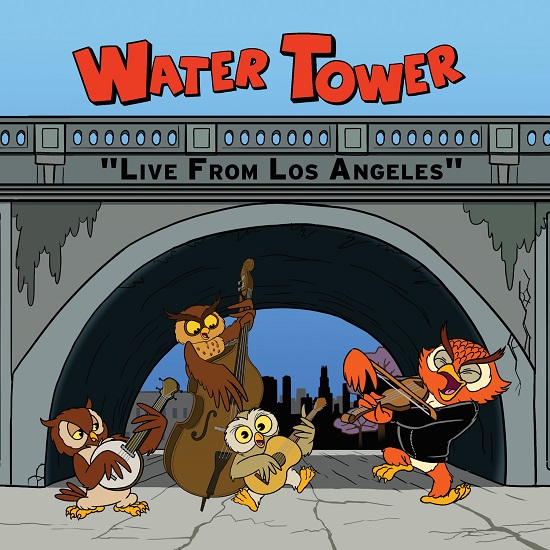
So, no pressure then. Palomino Studios in LA was booked by Water Tower for the day after a two-month tour while the tour energy was still fresh and everything would be recorded live in one day. It was traditionally the way string bands recorded; get everyone around a mic and the volume adjustment is done by moving away from or closer to it. Should have been relatively easy until the car broke down and the upright bass fell apart cutting four hours out of their session time. And they only managed to limit the songs to fifteen (or sixteen if you split out the opening segue). No pressure at all but, for performing musicians shit like this happens day in and day out. I’ll come back to that later.
I like the idea of the traditional string band; musicians who play and sing to a really high standard in a live or studio setting while keeping an Appalachian tradition alive. But things also move on and Water Tower do a couple of things that help keep the style fresh; they approach it with a sense of humour (not untypical in string bands) and they happily throw in influences from other musical styles and not always what you might expect; how about the percussive acoustic guitar-led cover of Tupac’s ‘California Love’? The link is the location, but I certainly wouldn’t have seen that one coming.
The album opens with a solo banjo version of ‘The Star-Spangled Banner’ (no Hendrix pyrotechnics, just tight, technical playing featuring some nice double-stopped passages) which leads into a cover of Doc Watson’s ‘Reuben’s Train’ showcasing the talents of all the players. The traditional string band tunes that give all the players the chance to improvise and show their abilities form the backbone of the album; ‘I See the Light’ is a slow triple-time piece with a high-register Kenny Feinstein vocal and intertwining banjos, ‘Lonesome Blues’ rattles along with instrumental virtuosity and superb harmonies and ‘Stay the Night’ flies along at breakneck speed hinting at the pace of the recording process, particularly in the spoken outro. And there’s a version of ‘Cotton Eyed Joe’ (yep, the same one that Swedish band Rednex covered when the UK rave scene finally jumped the shark).
These tunes are all great fun but the album becomes really distinctive when the influences that the induvial band members bring feed into the songs. ‘Radio’ is punk Americana with a couple of Clash references, ‘George Washington’ highlights our mortality and transience while taking a sideswipe at internet conspiracy theories and ‘Skante Warrior’ digs into the dark world of meth-heads which is contrasted with the gorgeous falsetto Beach Boys/Four Seasons harmonies. And then ‘AM PM’, with a Jackson Browne/David Lindley feel is a very rare thing indeed, a song about supermarket price offers.
Coming back to the recording process, everything was recorded live in two takes for each song and it’s mainly the first takes that feature on the album. There are three things about this album that grabbed my attention; the playing and singing are outstanding, it feels like the band are having fun and it made me explore a concept that I had no knowledge of (the urban mythology of meth-heads explored in ‘Skante Warrior’). Enjoyment and instruction.
‘Live from Los Angeles’ is a great capture of the live energy of Water Tower and it’s released in the UK on Friday August 11th. If you want to capture the real thing in the UK, Water Tower will be touring the UK and Ireland from August 10th. You can find the dates here.
As an extra bonus, here’s a live video of ‘Take Me Back’:
When Allan reviewed the album “Just Beyond the Shine” at the start of 2021, it shone a light all the way from Laurel Canyon into a cold British winter. The album was all warmth and light, in stark contrast to the grey and dismal London still in the grip of a COVID lockdown. It was a beacon in the dark days pointing to a better place. We’re pleased that Jonny Miller from Peach & Quiet has shared his 2021 high points with us.
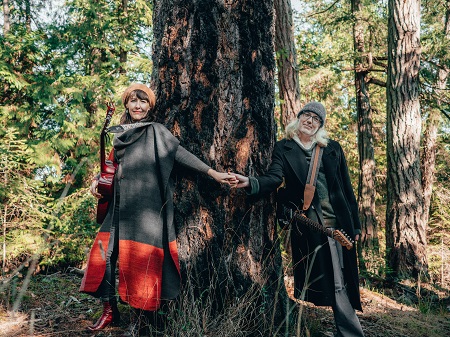
Ok, let’s try this, in no particular order:

BBC Scotland album of the week: the ever-amazing Geraint and Deb Jones introduced our duo to Europe, and even landed us a plum spot as BBC Scotland’s “album of the week”! As a major Jimi Hendrix fan myself, it was surreal to be on the BBC, as I’ve loved listening to Jimi’s BBC moments. And for Heather, who was born in Wales, I know it was a pinnacle for her as well.
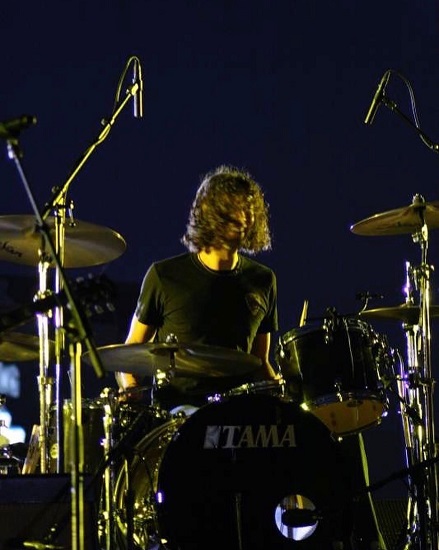
Clark Becker, drummer: LA drummer Clark Becker is one of the most musical and artistic drummers I’ve ever worked with, and I know someday the rest of the world will feel the same. Due to the pandemic, we both doubled down on our remote recording skills and gear, and have been cooking up some tasty tunes. A bromance for the ages, miss ya brother!
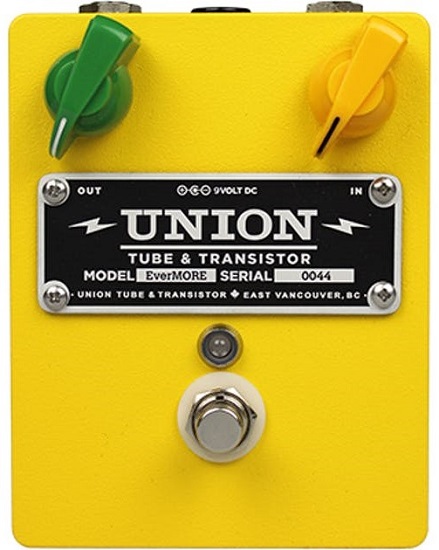
Union Tube and Transistor “More” guitar pedal: what can I say about this pedal that hasn’t already been said? It is the key to many electric guitar players “sound”, and I can’t imagine going back to playing without it. Big shout out to Paul Rigby (if you don’t know who Paul is, look him up, he’s a legend out here in Western Canada) for turning me on to Union, and that particular pedal. Thanks man!

Curried coconut miso lentil soup: I’ve been making variations on this soup for years now, but I think I’ve reached new levels of yum during the past year. Currently I’m rocking a mix of red and French lentils. One of the keys to this soup is using multiple types of lentils, which creates a complex and rounded flavour profile, to my taste buds at least. Just writing this is making me crave a bowl of this hardy nectar of the gods and goddesses.

Home: is there anything more important than liking where you live, in these times? Being here, amongst the trees, between a lake and the ocean, with our little feline pal, Miles, has kept us (mostly) sane. I can’t imagine being anywhere else (except on tour in Europe … someday … hopefully!).
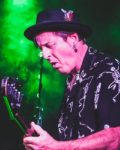 A producer, a photographer and two musicians walk into a pub. Sorry, there isn’t a punchline to this; it’s just what happened. A quick pre-Christmas beer with some music business friends to chew the fat; what do you think we talked about? As always with these semi-unplanned sessions something good came out of it. We’ll leave it to Graeme Wheatley, bass player and songwriter with the band Deep Blue Sea to tell the story, enhancing it with some music trivia. You might want to start this piece whenyou have about an hour to spare because it’s a bit addictive, especially after Riot Towers made a contribution,
A producer, a photographer and two musicians walk into a pub. Sorry, there isn’t a punchline to this; it’s just what happened. A quick pre-Christmas beer with some music business friends to chew the fat; what do you think we talked about? As always with these semi-unplanned sessions something good came out of it. We’ll leave it to Graeme Wheatley, bass player and songwriter with the band Deep Blue Sea to tell the story, enhancing it with some music trivia. You might want to start this piece whenyou have about an hour to spare because it’s a bit addictive, especially after Riot Towers made a contribution,
Sitting in The New Cross House pub the other night with Allan McKay (something that could very easily become habit forming), we were talking about his series of guest articles “High Fives” in Music Riot – sign up now if ya haven’t already!
I’ve written a few before and always like rambling on about whatever, so I was happy to quickly volunteer to write one for this Christmas – even before Allan gave me my first pressie of the year – even if I had no idea what to waffle on about.
We were with Iago Banet, a guitarist from a band that I’ve heard are not that bad and we were talking about a gig we did a few weeks ago. Our singer, Dre Smith, had lost her voice and we were doing the gig as a 3 piece – playing songs we’d never played before. I proudly boasted that I’d sang the entire lyric to “Blinded By The Light” by Brucie without a single rehearsal. Allan asked if I liked Manfred Mann’s version or the original best, then Iago reminded me that after 3 attempts we’d had to abandon “All Along The Watchtower” because I kept getting the first line wrong!!! Pride comes before…
Anyway, this conversation led to the topic of this High Five.
Five covers that I think are better than the original.
Only my opinion here – but when I got to thinking about it – there’s maybe 20 or 30 I could muse about. So, I thought I’d kick it off with two people who I consider to be un-betterable – but concede that in these two occasions, they are bettered.
Song 1
All Along The Watchtower – Bob Dylan – Jimi Hendrix
OK, if you know me at all, you may have heard me at sometime mention the name Bob Dylan. He’s the cat, the verbal acrobat-tery, the lyrical dexterity and temerity in all sincerity. A couple of weeks ago we were playing Bude R&B Festival, which involved a good 4 hour drive back and forth. Amanda Dal, our wonderful drummer, asked me, unprompted, to play the three albums Bob recorded in 1965 that “invented Rock Music as we know it”. Much to Iago’s horror. So we had a great journey back and forth listening to Bob. It’s Amanda’s turn next, so I am going to get 4 hours of singer songwriter LP. The fact that she’s a ringer for Bob makes me favourable disposed to her from the get go – so – I’m ok with this!
Anyway, some people say (fools that they are) that any cover of a Bob song is going to be better than Bob’s version. BUT THEY ARE WRONG!!!! This has only ever happened once in the whole wide universe since the beginning of time. And only one person could a done it. Jimi. Y’know, I’d love to be able to wipe the tape and hear Jimi’s version of Watchtower again for the first time. Can you remember that moment? I can’t. But listen to it now. The swagger, the invention, the sass, the sheer coolness. Four minutes of perfect cool. If Jimi hadn’t recorded it, would we remember the original? Was it just a fairly average track on a subdued and pared back album from Bob who might have been wondering at the time where he was going next. Recorded in 1967 after the “fall” it was a total turn away from the more blues inspired electric albums and a return to his more folkie side, but Jimi took this track, rocked it up, funked it up and delivery to my mind one of the greatest little guitar pop songs of all time.
Oh, BTW, the title of Bob’s album, John Wesley Harding. It was named after a Texan outlaw of that name – only they spelled it wrong!!! He was called John Wesley Hardin.
Compare and contrast:
Song 2
Nothing Compares 2U – Prince – Sinead O’Connor
I was a big Prince fan. Still miss the guy. He might have had demons and might have been just a tad obsessed but look at the catalogue of pop songs. Inventive, fun, joyous, rude, rock and raunch and lovesexy. He made pop a bit dangerous, a lot of fun and a lot of cool – combined a bit of Jimi, a bit of Marc, a bit of James Brown and a lot of genius. Until Sinead covered this song I would not have thought anyone could touch the little chap at his own game. I kinda thought Prince songs were indelibly stamped with Prince’s logo. You can’t touch this….
I wuz wrong. The frailty and fragile nature of the song fits Sinead and both somehow meld. She is the song, the song is her. That just doesn’t happen very often – if at all. That revolting phrase “you owned it” churned out on brain dead TV talent shows ad nauseam for once applies. You can’t think of the song without thinking of Sinead and vice versa. They might be so entwined that it overshadows her career.
OK, that’s two down and just to sum them up, nobody else has done a cover of a Prince song better than Prince and ditto Bob. Argue away, I’m not listening.
Compare and contrast:
Song 3
With A Little Help From My Friends – The Beatles – Joe Cocker
This is weird. The Beatles FFS? The greatest band ever. The greatest song writing partnership of the 20th century. The band that wrote the book (and the sequel). Have you heard some of the covers? “Hey Jude, Hey Bing”? Trust me, it was an album. My dad had it. Can you imagine the scene in our house? He was a jazz musician and I think he made this one attempt to be down with his son. He’d spent some futile time trying to tell me that all of this pop music stuff was nonsense and real music would eventually come into its own and Benny Goodman, Duke Ellington et al would be on Top of the Pops (Pops in this case being hep cat chat for Dads). Suffice to say most covers are cheesy in the extreme or just for shock value with nothing of value added. From Matt Monroe to Siouxsie Sioux. But, Joe? That voice. That presence. That simple honesty and stripped back truth. It’s a song, dare I say, that Paul didn’t really think was the Dog’s Bs so he suggested that Ringo sang it as a little bit of fun “What would you do if I sang out of tune?” and the whimsy fitted the feel of Sgt Peppers. But it was far from a stand-out track.
Now, fast forward a mere year or so. On stage at Woodstock and Joe says “the title of this song says it all”. The song is imbued with something more. A part of the hippy dream is captured in the performance. It’s a time piece. Oh and that voice? Come on. Just go have a listen. Band ain’t too bad either.
Song 4
Respect – Otis Redding – Aretha Franklin
Like Joe, this cover takes the song into places the original didn’t. Like the others too I guess. But with this one, you start pretty high up – with that voice, Otis. A voice that can quite easily make you cry. My Girl? Try A Little Tenderness? I Been Loving You Too Long? I’m tearing up now. And I’m a tough guy…
But Aretha takes a lyric that just might veer towards a bit misogynistic these days – y’know, man works all day – comes home to little lady cooking for him and expects a bit of R – E – S – P – E – C – T – and she makes it the first bona fide feminist mega hit defining moment of the decade. Oh yeah, and it was her major first hit after 10 years fighting against “the man”!!
What Aretha did changed the world. A cover version of a pop song changed the world? Yes, that’s what I said. Made a massive difference to the feminist movement and the civil rights movement. The impact of this little pop song can’t be ignored. That’s how deep my love is.
Oh, BTW, Otis didn’t really like the cover – but learned to live with it when the dosh rolled in – and also – listen to his version – most people think the lyric “R – E – S – P – E – C – T find out what it means to me” is part of the original.
Song 5
Girls Just Wanna Have Fun – Robert Hazard – Cyndi Lauper
For years I’d thought Prince wrote this especially for Cyndi. Someone told me some Fake News and I never questioned it. It’s a great song and it seemed believable. It’s my wife’s favourite “getting ready for Friday Night” song – so I had to include it for her.
There’s not a great deal to say about it other than, in Cyndi’s hands and voice, it’s perfect pop. In Robert Hazards? Well, have a listen to the song below. My main question is, How did Cyndi hear this very very average song and say “I can make this song a mega hit that will last generations and become Graeme’s wifes’ favourite “getting ready for Friday Night song” for all time”? I dunno the answer but one thing I will point out is, the song lasts 2 minutes and 30 seconds and the actual track lasts 4 minutes and 30 seconds. And by strange coincidence, when my wife says she’ll be ready in 15 minutes… you can fill in the rest.
Just before I trot off to have a mince pie, there were a couple of things I considered but rejected and hopefully some of these will incite you to invective 🙂
- Leonard Cohen covers – it’s easy to say other people sing them better than Lenny. That’s not the point. We can all say a photograph of a tree looks more like a tree than a Van Gogh painting of a tree. I don’t know where I’m going with that – other than Lenny is the Van Gogh of pop – funny, sad, dark, deep, tortured and Chaplinesque – there’s a crack in everything – that’s how Lenny gets in. I like his cracks. In his house there are many flaws – all of them interesting.
- Led Zeppelin – when you actually claim to have written all your covers yourselves – it doesn’t apply.
- Anyone covering Tom Waits with a gravelly voice – don’t be silly (Sir Rodney).
- Anyone covering Tom Waits with a lovely voice – as above.
- The Blues – it’s totally impossible to compare Crossroads – Robert Johnson to Cream. Both are wonderful in their own way – and I bet you can think of lots more examples. So, off you go, your challenge is now to name 5 blues songs that have brilliant originals and brilliant – but significantly different – covers.
Many thanks to Allan for allowing me to stop work for 3 hours to write this 🙂
Have yourselves a merry little Christmas, if the fates allow.
Cheers
Graeme
Written before the election December 2019 (I might not be in such a frivolous mood after that).
Sorry Graeme, but we need to have the last word here (not about the election, not even going there), especially after squeezing in two High Fives in one piece, but we did mention another song, which was a band covering their own song. Thin Lizzy’s “Nightlife” version of “Still In Love With You” should have pushed all the buttons as a duet between Phil Lynott and the wonderful Frankie Miller, but it was a bit of a mid-tempo plodder. Someone obviously worked out that it was a potential anthem, slowed it down, stuck a truly wonderful Brian Robertson solo in there and, voila, rock classic.
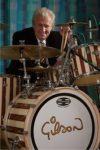 Exactly a year ago we published an interview with Gilson Lavis about his second career as an artist, running parallel with his day job as drummer with the Jools Holland Rhythm & Blues Orchestra (and let’s not forget Squeeze, where he got his first taste of fame). The interview concentrated on the upcoming exhibition of his artwork at the Salomon Arts Gallery in New York; a year later it’s time for London to play host to his evocative images. If you missed the interview, here’s a quick recap (with a few examples of Gilson’s work).
Exactly a year ago we published an interview with Gilson Lavis about his second career as an artist, running parallel with his day job as drummer with the Jools Holland Rhythm & Blues Orchestra (and let’s not forget Squeeze, where he got his first taste of fame). The interview concentrated on the upcoming exhibition of his artwork at the Salomon Arts Gallery in New York; a year later it’s time for London to play host to his evocative images. If you missed the interview, here’s a quick recap (with a few examples of Gilson’s work).
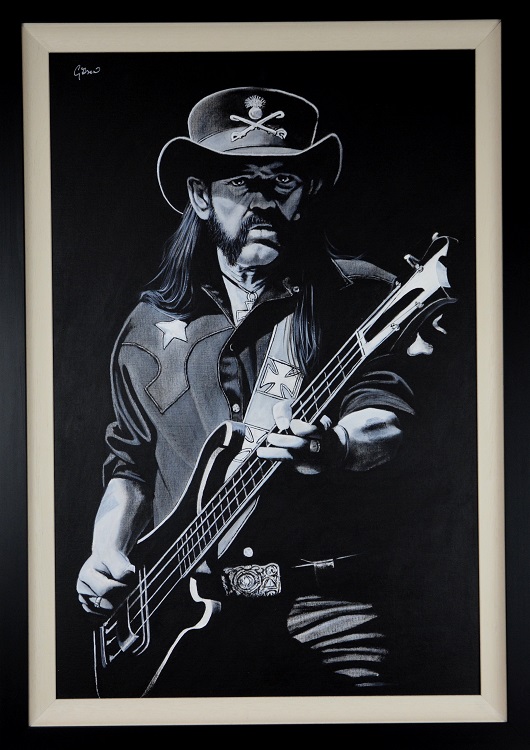
As Gilson’s musical career developed, he made use of his leisure time on tour in a constructive way; instead of the usual rock ‘n’ roll recreations, he went back to drawing and painting using the material closest to him; musicians. The day job (particularly with Jools Holland’s Rhythm & Blues Orchestra) gave him the opportunity to see of the world’s greatest musicians at close quarters and he’s made the most of it, creating some fabulous works of art that he’s now exhibiting and selling. In addition to the personally-observed pieces, there are also pieces created from photographs of performers as diverse as Ray Charles, Tony Hancock and Jimi Hendrix.
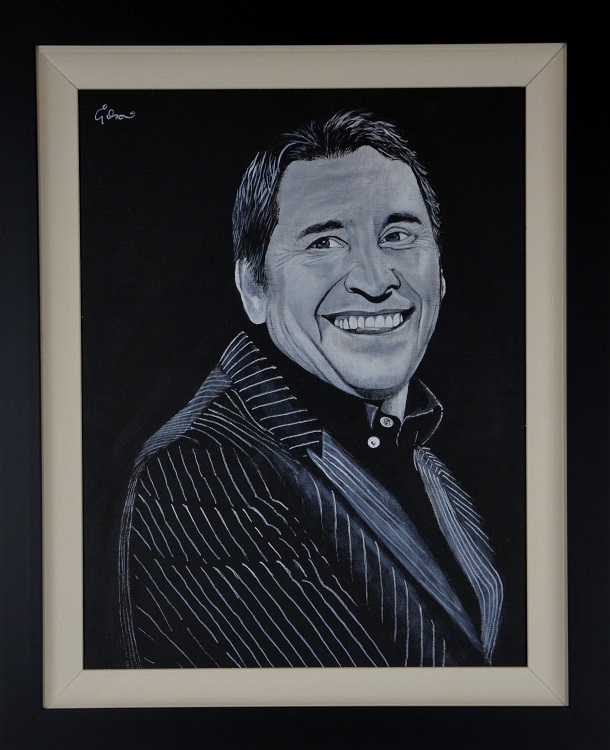
So, back to 2018 and Gilson has a London exhibition, “Gilson Lavis: From Drums to Canvas”, at the Karma Sanctum Soho Hotel from July 5th to August 12th. It’s a must-see event, but don’t take my word for it, here’s Gilson’s take on the exhibition: “I am thrilled to have the opportunity to show some of my artwork at the Karma Sanctum Hotel in Soho. The ethos of the venue and the subject matter I focus on in my paintings combine superbly well. A great venue and a great privilege. I can’t wait !”
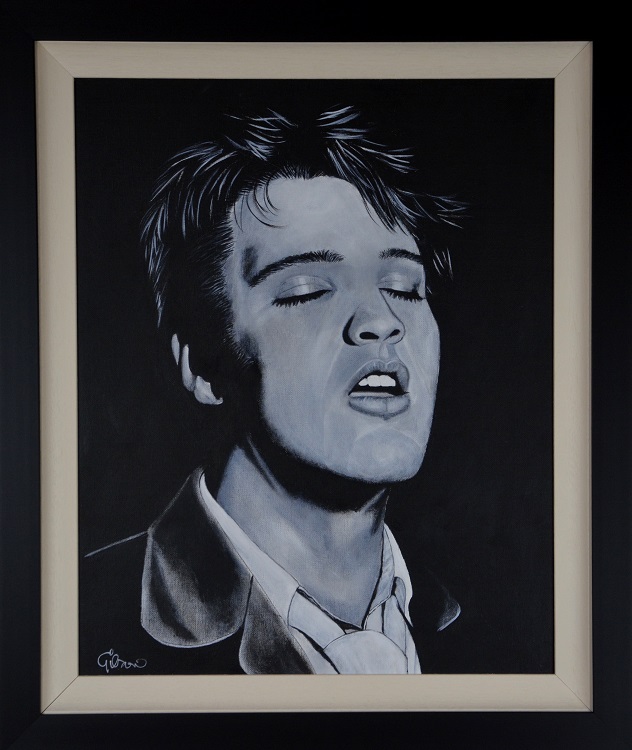
My advice is to get down to the Karma Sanctum to see this exhibition; apart from the unbelievable quality of Gilson’s work, you never know who you might bump in to admiring their likeness. And if you bump in to Gilson, say hello to him; he’s a lovely guy and he has a huge store of music business anecdotes.
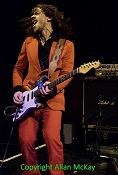 OK, so it’s Shoreditch on a Friday night. Normally I would rather eat my own body weight in guitarists’ nail clippings than visit a Shoreditch venue on a Friday night but, in this case, I’m making an exception because the venue and the artist are a little bit special. Rich Mix is a charity and social enterprise comprising a cinema, performance space and food outlet in a building which at one time was a garment factory (when we made garments in the UK). John Fairhurst is a bit special as well; his style is predominantly blues, but don’t expect third or fourth generation, ironed-out gutless blues because this guy taps into the feel of the original mid-twentieth century originals with a little side order of Indian classical tradition and some Hendrix and Neil Young for seasoning. His songs are featured in two films to be released in 2015, “The Beat Beneath my Feet” and the Scorsese-produced “Tomorrow” and his latest album “Saltwater” (highly recommended by MusicRiot) was released in late 2014. So we’re looking forward to this one.
OK, so it’s Shoreditch on a Friday night. Normally I would rather eat my own body weight in guitarists’ nail clippings than visit a Shoreditch venue on a Friday night but, in this case, I’m making an exception because the venue and the artist are a little bit special. Rich Mix is a charity and social enterprise comprising a cinema, performance space and food outlet in a building which at one time was a garment factory (when we made garments in the UK). John Fairhurst is a bit special as well; his style is predominantly blues, but don’t expect third or fourth generation, ironed-out gutless blues because this guy taps into the feel of the original mid-twentieth century originals with a little side order of Indian classical tradition and some Hendrix and Neil Young for seasoning. His songs are featured in two films to be released in 2015, “The Beat Beneath my Feet” and the Scorsese-produced “Tomorrow” and his latest album “Saltwater” (highly recommended by MusicRiot) was released in late 2014. So we’re looking forward to this one.
To start up the evening, DJ Chris Tofu warps and bends blues with electronica and samples to build up the atmosphere before the John Fairhurst Band really kickstarts the event. The “Saltwater” album has some fairly big productions, but the live set is a power-trio affair delivered by John, Pete Episcopo (bass) and Toby Murray (drums). While the focus is always on John Fairhurst’s playing and vocals, this set-up only works if the rhythm section is at the top of their game and Pete and Toby certainly don’t disappoint, providing a solid foundation for the songs and John’s extended solos. The set leans heavily on “Saltwater” material, featuring the Mississippi John Hurt classic “Pay Day”, the Hendrix-inspired “I’m Coming Home” and an astonishingly powerful version of the album’s title song to close the set. John Fairhurst’s playing is raw, loud, phasers-set-to-stun blues; it’s not for the faint-hearted 70s-era Clapton and Joe Bonamassa followers, but it’s a glorious earthy noise and the quality of the playing is stunning. I’ll certainly be having more of that later in the year.
As a bonus (well, this is part of the London Remixed Festival), the final live set of the evening is a collaboration between producer and live remixer Reverend Rockwell, John Fairhurst and Boxcar Joe Strouzer. You can’t argue with the performances and it’s an interesting experiment, but the programmed beats really aren’t a match for three great musicians playing together as a unit. Nothing wrong with it, but it just wasn’t the highlight of the night.
Things are looking good for John Fairhurst this year. He has a newish album to promote and, on the evidence of tonight, he’s going to win new fans every time he plays. The fact that his music is featured in a couple of new films as well is probably more valuable than radio plays in the current climate; I’m really hoping that things work out for him.
And how do I feel about Shoreditch now? Well, it would be great if it was all like Rich Mix, with a diverse audience and staff that make you feel that they actually like having you in their venue. It makes a huge difference to the entertainment on offer and the people who pay to see it when profit isn’t the only reason for opening the doors on a Friday evening. Fair play to Rich Mix.
Click here to see some of our great photos from the gig.
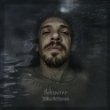 If you happen to have dipped a toe in the pool that is the British blues scene recently, you may have noticed that there are some very snappy critters swimming there waiting for the unwary. As with any scene that’s out of the mainstream, it’s inevitable that cliques develop, a fact that isn’t helped by too many performers chasing too few fans. It’s a classic supply and demand situation. As well as reducing the cash available to performers, it creates a situation where greed and selfishness seem to be excusable and some of those critters in that pool are piranhas. You can hear accusations of nepotism, award-rigging and other bits of nastiness, but the worst thing you can do is to question someone’s authenticity, which is ironic given that the players who are currently really successful are imitating the players from the 60s and 70s who imitated the original blues artists from the 30s and 40s.
If you happen to have dipped a toe in the pool that is the British blues scene recently, you may have noticed that there are some very snappy critters swimming there waiting for the unwary. As with any scene that’s out of the mainstream, it’s inevitable that cliques develop, a fact that isn’t helped by too many performers chasing too few fans. It’s a classic supply and demand situation. As well as reducing the cash available to performers, it creates a situation where greed and selfishness seem to be excusable and some of those critters in that pool are piranhas. You can hear accusations of nepotism, award-rigging and other bits of nastiness, but the worst thing you can do is to question someone’s authenticity, which is ironic given that the players who are currently really successful are imitating the players from the 60s and 70s who imitated the original blues artists from the 30s and 40s.
Ok, so here’s where that was all heading; I’ve been listening to an album by John Fairhurst. The album’s called “Saltwater” and it’s not full of tasteful imitations of Clapton playing “Further on Up the Road” or “Key to the Highway”; the inspiration here comes from Howlin’ Wolf, Muddy Waters, Little Walter and many others. The smoothness has been filtered out and this goes back to the raw earthiness of early country blues and Chicago electric blues.
John Fairhurst is originally from Wigan; he now lives in Bristol and recorded this album in Bristol and London with the help of Toby Murray (drums), Joe Strouzer (harmonica and vocals), Emma Divine (vocals), Tim Loudon (bass), Luke Barter (bass), Jago Whitehead (drums & percussion), Phil Jewson (piano), Saul Wodak (guitar effects) and Alex Beitzke (bass). I have a little confession to make about the album; on the first listen, I was halfway through before I actually started to get it (during the guitar solo on “I’m Coming Home”, actually). I blame it on the previous review I did, which was a very cleanly-produced singer-songwriter and it took a while to move from that to the over-driven guitar, wailing harmonica and Tom-Waits-dukes-it-out-with-Mark-Lanegan vocals. So let’s go back to the start.
The two opening songs, “Breakdown” and “Who You Fooling” get things off to a raucous start with plenty of amped-up slide and harmonica to get things rolling before the album’s only cover, the Mississippi John Hurt song “Pay Day”, which is much gentler, using the old country blues devices of repeated lines and call and response with the help of the Dean Street Choir. There’s even a sneaky little Eric Clapton reference at the end. “More More More” and “Time Goes By” are rooted in the rural, country blues tradition, the first having a UK skiffle feel while “Time Goes By” could be Tom Waits with the badly-tuned pub piano accompaniment.
You couldn’t really describe “I’m Coming Home” as blues; it’s a mutant Jimi Hendrix/Neil Young hybrid with “Voodoo Chile”-style riff and fill playing in the verses and a Shakey-style solo from the “American Stars and Bars” era. It’s the first of the album’s epic pieces. “No Shelter” is another elemental piece built around a simple (but loud) guitar riff and a reasonably good choice for the album’s first single while “Black Cat” is pure Muddy Waters; it’s a straight-ahead twelve-bar with belting harmonica and that always sounds good to me. So, more of the same to finish the album off?
No way; the penultimate song, written by the whole band, is “Dance in the Pines”, a mad surf-punk piece which splices DNA from The Cramps, Dick Dale and The Ventures. It’s off the wall and it’s brilliant. The album’s closer and title track, “Saltwater” is the magnum opus and absolutely has to be the last track; it wouldn’t be as effective anywhere else on the album. The song, which is a restyling of the Robert Johnson “Crossroads” story substituting the ocean for Clarksdale, has the singer refusing to shake hands with The Devil. It’s an epic which starts with acoustic guitar and vocal (slipping into a Wigan accent) which builds through a rural bluegrass-tinged to a kitchen-sink finale featuring Emma Divine delivering a vocal which easily equals Clare Torry’s famous performance on “Great Gig in the Sky”. And it’s the last track on the album because you can’t follow that; job done.
If you’re sick of hearing second and third generation blues revivalists recycling smooth guitar licks and bland vocals (no, I’m not naming names) then this could be just the album for you; don’t file under easy listening.
Out now (JF005).
So it’s time to move on to the second half of the seventies and the early eighties and we start off with the P-word.
AM – How did you react when punk came along then?
PB – Loved it; I actually loved it and weirdly I wanted it to do what it wanted to do because up to that point my heroes were not punk at all and the very antithesis of punk. I wanted it, because I would have been about seventeen then, leaving school, and just starting to think about playing music in pubs and got a band together; well, actually, I got a duet together with Martin Gore (yes, that Martin Gore) and we were trying to write songs. He liked, I don’t know who he liked, I think it was Simon and Garfunkel at the time and he did like Sparks and David Bowie. I liked David Bowie but I wasn’t sure, I didn’t trust him which now, I think, was probably wrong, but I didn’t get the idea that superficial and chameleon-like was his theme. At the time I thought ‘I don’t believe he really means this’ and at that time it had to mean it and that meant a lot to me and I was probably wrong and Gore was probably way ahead of me on that. So we wrote songs which I tried to make melodic and soulful and he wanted to make strange and weird. I taught him how to play guitar and he was a better guitar player than he is, well, what he’s ended up as. We were writing some interesting songs at the time and we went out as this strange band and the punk happened, halfway through this band.
I had hair like Marc Bolan at the time and he had a bubble-cut but we found ourselves on these punk bills. I’d started writing a few songs as well, so I found myself as a solo person on these punk bills for no reason whatsoever because I had nothing to do with punk musically but I liked the fact you could play somewhere and there was energy there and I started listening to other people who were playing and I thought I’ll have a listen to this, so I went along to see some bands. I saw The Buzzcocks, The Ramones and The Talking Heads when they first came over, I saw The Clash once and there was a big fight so I didn’t hear much of The Clash, but that wasn’t the point in a way. I tended to like a what went on afterwards in the post-punk era; I got really well into that because there seemed to be room for bands like Television and The Fall with some of their lyrics which, at that point, were suddenly taking over for me and I went from trying to write songs like James Taylor with three words in them to two chords and “War and Peace” over the top of them; “Ulysses” or something like that, but then there were bands that that was feeding into at the time like The Fall. I certainly got heavily into The Fall and the more experimental bands but I would still listen to “The Modern Dance” by Pere Ubu and then go home and listen to “Mud Slide Slim and the Blue Horizon” by James Taylor because I think that’s what it’s about; they’re not dissimilar in the sense that the person who’s responsible for the music does what he wants it to do. There’s too many categories, in a way.
AM – I know Television, “Marquee Moon”, everybody claims now that it’s always been their favourite album and at the time…
PB – They’re fucking lying; I tried to get everyone into that and a couple of people got it, but for once the rabid NME press was right about this.
AM – For me it’s still one that I’m happy to get the vinyl copy out and stick it on the turntable.
PB – It is actually an album I can listen to at any time and that’s a rare thing. Sometimes, even your favourite albums you think ‘I’m not in the mood for that’, but I can be depressed, I can be happy, I can be whatever, but when Television comes on, that’s it.
AM – So, that was punk, what about what came after that.
PB – Punk was exciting and I was involved in the energy of it; everywhere you went there were gigs. I sounded like Leonard Cohen at that time but anything went and that was the beauty of it. I wore flares and had long hair at the punk gigs I did and it was, sort of, ok. You’d get comments, but that was sort of the point; wait until Dexys Midnight Runners sing about ‘you’re so anti-fashion, wear flares”. You could do anything you liked, it was sort of Dadaist spirit. It was very early on when the fashion thing kicked in, the Kings Road punks, and it was weird because I felt like I’d transcended that because I hadn’t changed. I didn’t even cut my hair so I was like David Crosby amongst the punks.
AM – So presumably when the synthesisers kicked in that wouldn’t really have been your thing.
PB – When the post-punk thing happened, I used to like some of the bands that became known as Krautrock, Can, Neu and the newer ones as well, Deutsch Amerikanische Freundschaft and Einsturzende Neubauten who were pure noise and distortion and the English versions of that like Cabaret Voltaire; I loved all of that. I thought there’s a synth thing going on and Martin got into it, so he buggered off and did Depeche Mode. Suddenly it turned into this really twee pop with no substance. I don’t hate pop music but I thought, with everything he knew, and the stuff he liked, I thought he would have gone towards Throbbing Gristle rather than this thing that happened, which seemed like it was going to be over in five minutes. For all I know he’s now a multi-millionaire and I’m sitting in a pub in Leigh.
AM – It’s a general thing that innovations like that come along, people make really good music and then somebody grabs bits of it for the mainstream and just dilutes it.
PB – That’s always happened. Bob Dylan wouldn’t have been anywhere if it wasn’t for The Byrds; fabulous as that was, I’d rather hear Dylan. I’m probably alone in the world in preferring “All Along the Watchtower” by Bob Dylan to the Hendrix version, even though I like Jimi Hendrix. I’m alone, even Bob Dylan said it’s a better version.
AM – Dylan’s songs have been interpreted by a lot of people; are they better versions or are they different versions?
PB – They’re different versions. Sometimes you can say they’re better versions but the thing I always try to get away from is ‘Dylan’s a fabulous songwriter and an icon of the twentieth century but he can’t sing’. So that means that if Judy Collins or some such does a version of “Idiot Wind”, it will be better, de facto, because she can sing. I could not disagree with anything, outside of UKIP, more vehemently than that. Bob Dylan and Sinatra are probably the best vocal stylists of this millennium. The reason I say that is because you try to play a Bob Dylan song and sing it and not sing a bit like Bob Dylan, not phrase it like him. The same with Sinatra, once you’ve heard “You Make me Feel So Young”, you try and sing that differently. Put your own slant on that; you can’t.
AM – I play and sing badly but I try Dylan songs like “I Shall be Released” and it’s always going to sound like Dylan.
PB – The Band did that; they’ve got some great singers in that band, and it sounded like Dylan; they couldn’t change the phrasing at all. You can sing it in a bland way or you can over-sing it; my worst nightmare is that I’ll wake up and “Positively Fourth Street” is covered by Mariah Carey. She would do it and you can guarantee you would have a queue of people saying ‘Oh, at last this song has been realised by a true singer’, but I would hunt her down and you’d see me on the Six O’Clock News if that happened.
 It’s a couple of years since we last spoke to one of our favourite guitar players, Billy Walton, so I arranged an interview before his show at “Tropic at Ruislip”. As an added bonus, the legendary Roger Mayer (search him online, but as a bit of a clue, he designed effects pedals for Jimi Hendrix) turned up as well because he’s been working with Billy for a few years now. Here’s what happened.
It’s a couple of years since we last spoke to one of our favourite guitar players, Billy Walton, so I arranged an interview before his show at “Tropic at Ruislip”. As an added bonus, the legendary Roger Mayer (search him online, but as a bit of a clue, he designed effects pedals for Jimi Hendrix) turned up as well because he’s been working with Billy for a few years now. Here’s what happened.
Allan – It’s been two years since we last did this, at Totteridge, and you were just about to release “Crank it Up”. What have you been up to since then?
Billy -A lot of stuff, we’ve been playing the Jersey shore, tons of gigs; we’ve been writing, writing with friends. There’s a lot of projects in the works right now. We did a whole live thing over the summertime; we had a mobile unit follow us around and we did a lot of recording with that and we caught the fun vibes on the Jersey shore. Right now I’ve been writing and I’ve got about eighteen or nineteen new tunes; maybe do another Billy Walton Band album we’re trying to work on then try and write with other people and have fun and put out some cool stuff. That’s our plans.
Allan – Before “Crank it Up” was released you were telling me that you thought the songs were stronger on that album.
Billy – Well, songwriting always evolves and it depends on what you’re feeling. With that one we were going for a Jersey shore laid-back, more soulful type of thing instead of just guitar pyrotechnics like the albums before that.
Allan – There were a few elements of early Bruce in there as well, the New Jersey feel.
Billy – Being from New Jersey that kinda comes out it’s always gonna come out.
Roger – It’s part of the DNA, isn’t it?
Billy – It’s where you’re from; it’s always going to come out. To dissect the Jersey shore music it’s kind of ahead of the beat, it’s driving all night, in a pumping club on the Boardwalk , and that’s what it’s about.
Allan – And how are the songs for the new album coming along?
Billy – There’s a good mix; I want to reintroduce more of the guitar pyrotechnics on the new album, we haven’t picked the songs yet so we just keep writing and we’ll figure out which ones are the best.
Roger – You haven’t actually decided on whether the line-up for the record is gonna remain constant. There would be no reason for every track to have the same personnel on it; is it fair to say that would be a step different from a production standpoint?
Billy – Yes, absolutely. On this tour we’re bringing two horns; Richie(Taz) is still playing with us back home but I brought these two horns with us just to switch it up a bit. It’s all about the vibe of the night and it’s the same thing with trying to create an album it’s about getting that vibe and whoever it takes to make that vibe happen.
Roger – If I can say one thing here: I don’t think your records have ever tried to
capture you playing live. You’ve done the live record, but a studio record is completely different from a live record because it gives you much more scope with what’s possible.
Billy – And I think that’s what we haven’t captured on our last albums; that live vibe. If you come out to a show, you know it’s controlled chaos.
Roger – And I think that’s true of Bruce (Springsteen)’s albums too. Live he’s fantastic but I don’t think his albums live up to the live performance.
Allan – And it’s a great experience, a Billy Walton Band live show because like Bruce and Southside Johnny, you never know what you’re going to get on the night, do you?
Roger – That’s true, when I was with Hendrix, we deliberately never played the same thing twice any night so you never knew what to expect and that’s a jazz thing as well, which makes it exciting. It means you can see the band three nights in a row and get three and get three different and I think that’s cool, rather than some note-for-note rendition which gets stale very quickly.
Allan – The last time I saw the band, which was at Barnet on the last tour, you played a solo where you threw the riff from “Kashmir” and the intro from the Chicago song “25 or 6 to 4” and that’s great because nobody’s expecting it.
Billy – There’s no rules and that’s what I was feeling at that time so I thought let’s get into it.
Roger – Well there are no rules, are there? That is the rule; there are no rules.
Billy – That’s right, the band’s having fun and if you saw us last night, tonight’s gonna be totally different and it’s got to be that way because sometimes even the band doesn’t know what’s coming next and that’s great.
Roger – Should they know?
Billy – They shouldn’t (laughs).
Allan – I saw Bruce at the Olympic Park and, you know this is coming, but he walked to the front of the audience, pulled out a request placard, turned towards the band, lifted it in the air and the band launched straight into the song; that’s the mark of a really great band.
Billy – Like us, the E Street Band are all music lovers. Everybody you see playing that way, you know they have a load of Motown records, they have all the Stax records and they still put them on and that takes them back. One night I went to hang out with the E Street guys in Philly and they played “Higher and Higher” and the place just erupted (Billy sings and finger-pops the chorus for emphasis) and afterwards everyone was just so excited that they did that song.
Roger – Because a great song played by great musicians gets a great reaction. It’s exciting and memorable.
Allan – So you’re in the process of raising funds to make the album now; how’s that going?
Billy – Well, there are many different things we’re trying to do and one is that we’re talking to this guy, Tony Braunagel who’s just produced Curtis Salgado, he’s done Taj Mahal albums and he’s interested in doing an album with us, but that’s not definite; it’s not in stone, we’re just raising funds for the next project. There’s always gonna be a project, because we’re always writing and we’re always playing, but right now that’s the one.
Allan – And that funding’s happening through indiegogo , isn’t it?
Billy – That’s right, indiegogo. The way the music industry has gone it’s a great way (to fund an album). It used to be that the label that gave you the money, the producer pays everything, you pay him back, but now fan funding allows the artists to do it themselves and own it.
Allan – And it allows you give something back to the fans that have funded it as well.
Billy – Absolutely, they feel a part of it; they get packages where they get so many CDs and other deals.
Roger – And that’s still only the beginning because it only takes you so far, you still have to try to get airplay. It’s still only the opening pawn move in a chess game.
Billy – You need a fish to catch the bigger fish.
Allan – Are there any guitar players that you listen to or you’ve worked with over the last few years that you would recommend to a UK audience?
Billy – That’s a good question; there’s a lot of great players out there but to name one; Freddie King! There’s a lot of evolutions of Albert King and Freddie King out there.
Roger – But the thing is can they write good songs? Not that they’ve got some licks that they’ve served up in a generic way. Can they write good songs? That’s what makes them stand out.
Allan – When I saw you play with the Henrik Freischlader Band in January, it struck me that he can write a good song and he has a very soulful voice as well.
Billy – The thing is, with players that I like, they have something that you can say “I can tell where they’re from”, they’re unique. They’re not just generic Clapton copies; that’s what I don’t like. What I do like is, there’s a couple of bands in New Jersey that came up after Katrina from New Orleans and these cats can play and you could tell they were from New Orleans; you could hear it, you could feel it and that’s what I like. And it doesn’t have to be a guitar player, it can be any musician.
Allan – I was surprised a few years ago when I read a Bobby Bandiera interview and he was asked about new music he listened to and he said he didn’t listen to a lot but he did say that he liked Radiohead, which was a bit of a shock.
Billy – Well, Bobby might have been messing with the interviewer there (laughs).
Allan – We first met when you were playing with The Jukes; are you focussing on the Billy Walton Band now, or is there a chance that we might see you back with Southside in the future?
Billy – Absolutely. I’m friends with those guys, Southside is great; I enjoy the whole Jersey heritage and I still do gigs with them once in a while but I’m really trying to focus on my stuff. When you think about it there has to be more generations of music from Jersey. Everybody speaks about Bruce and Bon Jovi but what about Frank Sinatra, the Rat Pack in Atlantic City; there’s evolution there.
Allan – We spoke briefly during the first interview we did about some of the Jersey Shore bands and musicians; what is it that makes that scene so special?
Billy – There’s a lot to it. In summertime the Jersey shore is a vacation spot; everybody from Philadelphia, Washington and New York City hits the shore and along the shore there’s a party every night in the summertime and there’s clubs all along the Boardwalk and everybody meets their girlfriends and they dance, it’s that whole scene.
Roger – It would be like thirty miles of Blackpool but slightly classier. And it’s better than New York because the clubs are bigger.
Billy – What’s great about New Jersey too is the brotherhood of the bands. There are clubs next door to each other and when you go on break, you walk out and go and jam with your friend’s band next door and they come and jam with you.
Roger – A bit like New Orleans in a way.
Billy – With those guys we all know what each other’s doing and the players are interchangeable. We all get together and have fun and listen to music and talk music and that’s what’s different about it.
Allan – It’s great that Bobby (Bandiera)’s been on tour with Bon Jovi for what seems like forever now, but as soon as there’s a break in the tour he goes back to the Jersey shore and he’s playing McLoone’s Boathouse and places like that.
Roger – Because it’s fun. If you’re a musician why wouldn’t you want to do something different if you’ve been on a tour round the world and it’s boring as hell.
Billy – You’re right. You’re away from it all and you’re in a bubble. We played Churchill Downs in Kentucky in front of thousands of people with Bon Jovi and that night I got on a plane and flew home to New Jersey and played in front 150 people at a club, a jukejoint and I loved them both because I had fun.
Roger – We used to do that with Jimi (Hendrix, of course); straight off the stage and straight down the pub and jam, every night.
Billy – You wanna play, and you wanna have fun, youknow?
Allan – Have you noticed any changes in the UK audiences over the last 2 years?
Billy – Yes, there’s a mix; it’s not just the older demographic. We get the traditional blues fans coming out to hear a guitar player. Then you have the Jersey people who buy into that thing of having a good time and having a party and you get the younger crowd so it’s a great mix.
Allan – I noticed particularly at the gig in Barnet, on the last tour, there were teenagers wearing Billy Walton Band T-shirts and I thought that was great because I’ve seen a lot of blues players recently at shows where I’m the youngest person in the room, and that really worries me.
Roger – That’s really sad, man. You should look out for a band called the 45s; they sound like the Rolling Stones did in 1965 and Jimmy Page and the guy from Dr Feelgood gave them a bit of a leg-up, but this is guys that are seventeen and nineteen who wanna portray that energy. So the energy is there with younger people; I’ve been working with some younger people who still like the kind of music we’re talking about so it’s obvious that the music goes right across the borders.
Allan – And do you think we’re starting to see a move back towards guitar-based blues/rock again?
Roger – In a way yes, but I think people just generally want to see someone perform. You might not like “Strictly Come Dancing”, but at least it’s a live performance; whatever you say, the band’s playing live. So that from that standpoint, nine million people every Saturday are watching celebrities dancing to a live band. It can’t be all bad.
Allan – I’ve noticed that over the last year I’ve seen some great young and enthusiastic British blues/rock bands and I wonder how much of that is down to what guys like you are doing?
Billy – Well, you can find inspiration in many different ways. It could be guy playing saxophone that makes you want to pick up an instrument and try that but just getting out there and playing, that’s the main thing. I was fortunate to grow up in a scene in Jersey where I’d go out to a blues club and there’d be older guys and I’d sit in and I’d get my ass kicked every night and the there was a point when I’d go back down there and I’d kick their asses. They introduced me all these songs that I didn’t know and it was ‘“Born Under a Bad Sign”, what is that, what the hell, I’ll play it’. And it just opens you up and I was fortunate to have that, to be able to play with these people and let loose and go with it.
Allan – And I hear you had a good time playing with Walter Trout this week.
Billy – Yeah, Walter Trout, he’s a Jersey boy; he’s originally from Ocean City. We had fun; I tried to take my amp off the stage after we opened up and that wasn’t allowed so it was great, we jammed an Elmore James tune and had some fun with it.
Allan – And that’s what the Jersey scene’s all about I guess, isn’t it?
Billy – Absolutely; one hundred per cent. On tour, we have bands open up for us and most times we end the night with the band up on stage playing with us. It’s the party, that’s what it’s about to me; what’s gonna happen that night and what picture’s gonna be painted that night. And then tomorrow’s another one.
Allan – Well, great to meet up again, it’s always good to hear what you have to say and I’m looking forward to the show tonight now.
Billy – Thank you.
The Billy Walton Band are currently on the second leg of the UK tour, which finishes on November 26th at the 100 Club and you really should get out to see them. Failing that, help
the guys to fund the new album and grab yourself some nice goodies as well.
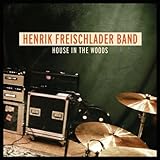 I may have said this before, but I love an album that opens with a statement of intent and “House in the Woods” does just that. The title track opens with a huge guitar riff backed by a smoky Hammond and you know exactly what you’re going to get, particularly when the lead vocal drops in on top of the guitar/organ interplay. The arrangements on this album lean quite heavily on the late 60s/early 70s power trio tradition of Jimi Hendrix, Cream and even Rory Gallagher with guitar riffs and fills punctuating the vocals; the addition of the Hammond of Moritz Fuhrhop to this powerful mix offers extra textures and another layer to the sound.
I may have said this before, but I love an album that opens with a statement of intent and “House in the Woods” does just that. The title track opens with a huge guitar riff backed by a smoky Hammond and you know exactly what you’re going to get, particularly when the lead vocal drops in on top of the guitar/organ interplay. The arrangements on this album lean quite heavily on the late 60s/early 70s power trio tradition of Jimi Hendrix, Cream and even Rory Gallagher with guitar riffs and fills punctuating the vocals; the addition of the Hammond of Moritz Fuhrhop to this powerful mix offers extra textures and another layer to the sound.
There’s one thing which makes this album stand above the rank and file of blues/rock albums and that’s Henrik Freischlader’s voice; it’s raw, powerful and, at times, incredibly emotional. Normally you expect singer/guitarists to excel in one discipline, but Henrik Freischlader is a great guitar player and a great singer and he’s equally convincing in all of the styles on offer here. “House in the Woods” and “Sisters” are blues riff-driven, while “Nowhere to Go” and “1999” are much more funk -influenced, but the first real revelation comes with “Breaking My Heart Again” where Henrik’s voice, rather than his guitar work, dominates for the first time. The first time I heard this song, I was convinced that it was a Paul Carrack lead vocal, and that’s not a comparison I make lightly. There are thousands of guitarists who can belt out high tempo blues tunes but, for me, the real singers are the ones who can perform well on the slower, more laid-back tunes as well. Henrik Freischlader is one of the real singers.
The second half of the album carries on in the same vein, with the funky “Take the Blame” and riff-driven “Hear Your Talking” leading into the ballad “Two Young Lovers” before the brooding menace of “With the Flow” and the closing slow blues of “Won’t You Help Me”. The album is a well-rounded collection of songs from ballads to fairly hard blues riff-rock; the band sound convincing throughout, but the vocals really shine on the two ballads “Breaking My Heart Again” and “Won’t You Help Me”.
If you’re into the great blues-rock players like Gary Moore, Johnny Winter and Joe Bonamassa, then you’ll love this album; the playing is always superb and there’s a song for everyone here, whether you want a heartfelt ballad, a riffmonster or something with a backbeat, they’re all here. Listen to this in the car at maximum volume.
“House in the Woods” is out on February 4 2013 on Cable Car Records.
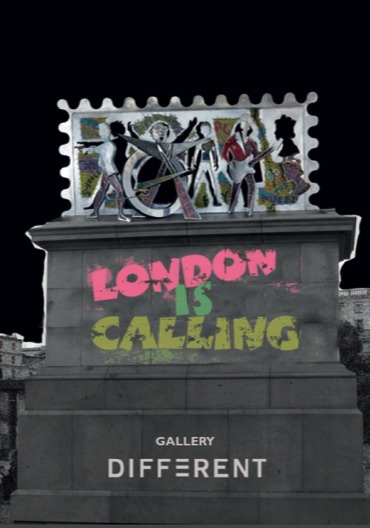 OK, I’m sorry that this is going to be London-centric but, at the moment, you can only see this exhibition in London at the moment and that’s just the way it is. So, my apologies to anyone who can’t actually get into central London before the end of August, but there are plenty of links to online resources to give you a flavour of this show.
OK, I’m sorry that this is going to be London-centric but, at the moment, you can only see this exhibition in London at the moment and that’s just the way it is. So, my apologies to anyone who can’t actually get into central London before the end of August, but there are plenty of links to online resources to give you a flavour of this show.Gallery Different is easy to find, about halfway between Northern Line stations Tottenham Court Road and Goodge Street on Tottenham Court Road, and surrounded by loads of welcoming pubs and interesting places to eat (the Riot Squad always researches background thoroughly).
“London is Calling” is an exhibition featuring music-related artworks by sculptor Guy Portelli, painters Chris Myers and Morgan Howell, mixed media artist Keith Haynes and photographers Charles Everest, Michael Ward and Nathan Browning. If you’re interested at all in the iconography of pop and rock music, you should really make the effort to see this exhibition.
The photography is all excellent, but the highlight for me is the recently-published selection of Charles Everest’s photos from the 1970 Isle of Wight festival featuring some absolutely stunning images of Miles Davis and Jimi Hendrix and many other great images of a hugely important event in British social history. Nathan Browning’s work is based on the photographic image, but with the addition of painting, ink and poetry pushing it towards multi-media territory.
Moving on to 3 dimensions, Guy Portelli’s dynamic sculptures successfully capture the essence of artists such as John Lennon and The Who while avoiding the stereotyped figurative representations which are so common in collections of British cultural ephemera.
Keith Haynes’ pieces are thoughtful and often ironic, constructed from original artefacts stripped down and reconstructed as creative images. The majority of the pieces are constructed from original vinyl singles and albums, with the exception of the wonderful “Acid Queen” which is made entirely from Smiley badges and is a piece which anyone interested in popular culture should make the effort to see.
Chris Myers’ paintings focus on divas through the popular music era and the Amy Winehouse pieces here are sympathetic representations of a great British torch singer while Morgan Howell delivers larger than life acrylic representations of iconic seven-inch singles from Elvis to The Clash.
Popular culture exhibitions in London can be very tightly-focussed affairs featuring 1 era or 1 medium but “London is Calling” covers a period of 50 years and encompasses photography, painting, sculpture and various multi-media forms.
If you live in or near London (or you’re visiting), go and see this exhibition. If not, check out some of the links; you won’t be disappointed.


